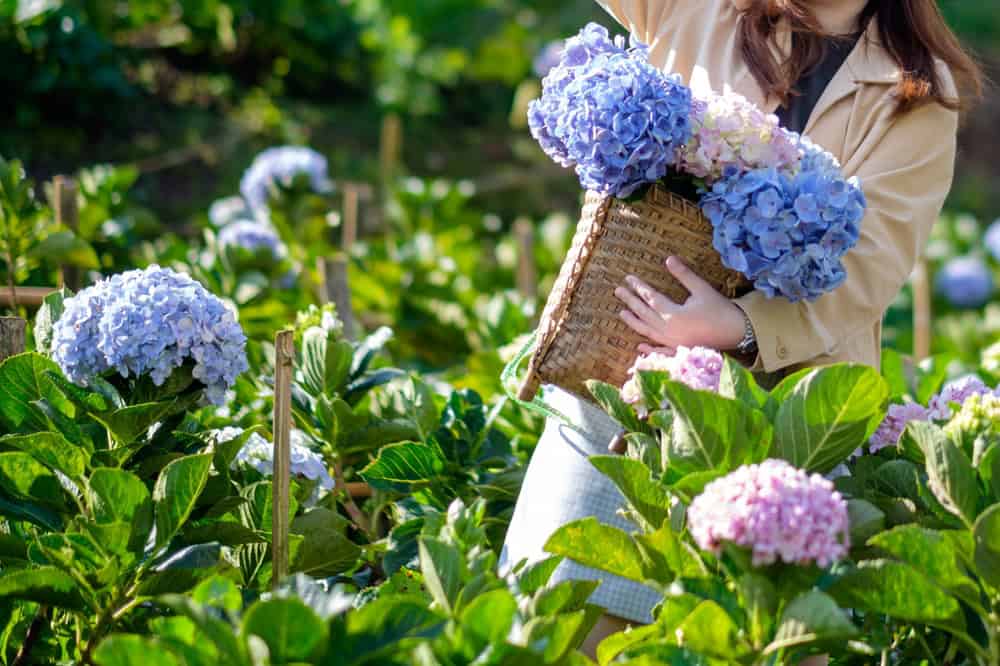
Hydrangeas (Hydrangea) are semi-climbing shrubs renowned for their vibrant and beautiful flowers. They produce large clusters filled with blooming florets that catch the eye. With such unique charm, hydrangeas have become popular ornamental plants that can decorate gardens or be grown in pots for aesthetic appeal. For those who wish to adorn their homes and gardens with them, this article offers a guide to help you get to know hydrangeas better, along with techniques for growing hydrangeas to produce abundant blooms, and tips for novice gardeners.
Getting to Know Hydrangeas Before Planting
Hydrangeas, or Hydrangea macrophylla (Thunb.) Ser., are medium to large shrubs that can grow up to 2 meters tall when planted in the ground, depending on the variety. Currently, there are over 80 varieties worldwide. The charm of this plant lies in the diversity of petal colors, such as blue, pink, purple, white, and cream. Some varieties can have their flower color determined by controlling the soil's pH level through watering, fertilizing, and the type of soil used. They are purely ornamental plants that enhance the atmosphere, making them popular for garden decoration or arranging in vases as desired.
Techniques for Growing Hydrangeas to Produce Beautiful Blooms
Hydrangeas are flowering plants renowned for their large, beautiful flower clusters filled with colorful petals that attract the eye. Growing hydrangeas to produce beautiful blooms is not difficult; growers just need to pay attention to details. Here are some excellent techniques that can be applied:
1. Plant in Well-Ventilated Areas
Hydrangeas prefer light to moderate sunlight, so you should choose a planting area that receives morning sun and partial shade in the afternoon. Additionally, plant them in well-ventilated areas that are not too damp to prevent powdery mildew.
2. Regular Watering Morning and Evening
Hydrangeas are plants that love water. In the first week, water them regularly in the morning and evening to help them adapt well to the environment. It is recommended not to fertilize during this period because the hydrangeas are adjusting and not yet ready to absorb additional nutrients.
3. Choose Soil with pH 4.5-5
Hydrangeas prefer slightly acidic soil, so choosing soil with a pH of 4.5-5 is ideal. You can add nutrients with a 16-16-16 balanced fertilizer that contains all essential nutrients, suitable for the general growth of hydrangeas. Regularly fertilize every 2-3 weeks in appropriate amounts until the hydrangea flowers start to show color, then stop fertilizing as it may cause the flowers to drop.
Things to Know When Planting Hydrangeas
- Sunlight Management: Allow hydrangeas to receive morning sunlight for half a day and avoid afternoon sun. If they must be exposed to sunlight all day, use a 50% shade net to filter the light.
- Watering: Water every 1-2 days, ensuring the soil is moist but not waterlogged. Be careful not to let water accumulate in the soil because hydrangeas like water but do not like standing water.
- Soil and Planting Materials: Suitable soil for hydrangeas should be loose, well-draining, but able to retain adequate moisture. The soil pH affects the color of hydrangea flowers.
- For blue and white hydrangeas, use soil with a pH of 4.0-4.5 (acidic).
- For red and pink hydrangeas, use soil with a pH of 5.0-5.5 (slightly acidic).
- Suitable Environment: Hydrangeas prefer high humidity in both the air and planting medium. Therefore, choose planting areas with high relative humidity but good air circulation. Avoid planting in enclosed areas or places with hot, stuffy air.
- Fertilization: During the vegetative stage, apply a balanced fertilizer. When promoting flowering, use a bloom-boosting fertilizer with a 2/1/3 ratio and stop fertilizing when the flowers start to show color.
- Flower Induction: This should be done in early winter by pruning the tips and applying bloom-boosting fertilizer.
By consistently applying these techniques, your hydrangeas will grow strong and produce beautiful blooms. However, always remember to observe the condition of your plants and adjust your care according to the planting environment.
Q&A: Growing Hydrangeas for Beginners
Q: Do hydrangeas like sunlight?
A: Hydrangeas do not like intense sunlight but prefer partial shade. They should receive morning sunlight or be planted under large trees to prevent leaf scorch.
Q: Are hydrangeas difficult to grow?
A: Growing hydrangeas is not complicated. You just need to pay attention to details and care for them properly. Then your hydrangea plants will grow and produce beautiful flowers for you to enjoy.
For those interested in growing hydrangeas and looking for a shop that sells high-quality hydrangea varieties along with various planting equipment, you can purchase them at Chaiyo Farm. We offer a wide variety of seeds and plants, including 13 varieties of French hydrangeas, and a full range of planting equipment for organic plant care, such as peat moss, pots, and fertilizers. If interested, you can order products through our website or drop by our store. For more information, contact us at info@chaiyofarm.co.th or call 02 015 0909.






